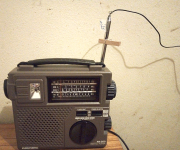wenzeslaus
Member
- Joined
- Aug 30, 2023
- Messages
- 149
I tested 4 lengths of random wire antenna in the house.
feet, length x4 (meters), MHz
12, 14.63, 20.5
15, 18.29, 16.40
25, 30.48, 9.84
35.5, 43.28, 6.93
spacing was 2-3" apart. time was 1/2 hour before to 1 hour after sunset, starting with the high frequencies first.
results:
20 MHz, no difference between all antennas.
15.30 MHz, no difference between antennas. you can test to see if there is any difference at all by touching the other disconnected antenna to the connected one. 12-15, no noise. 25-any, made noise. hard to tell any difference. 35-any, made a little noise. 12-25/35, made a little noise.
12.90 MHz, 35 noticeably faded compared to the others.
10.10 MHz, 35' was useless. the other 3 all seemed to get the same reception. touch test: 12-25, no noise. 25-any, no noise. any others made a noise.
7.80 MHz, all had the same reception. touch test: all made noise.
6.50 MHz, all had the same reception. touch test: 12-15, no noise. 25-35, little noise. 25-12/15, no noise. 15-35, loud noise. 15-25 made noise.
4.75 MHz, all had the same reception, except 35 was sort of faded and had higher noise floor.
4.00 MHz, 25 received signal, the others could not. background noise definitely changed volume between antennas. 12<15/25<35.
3.35 MHz, 25 received a strong signal, not so strong on 12/15, absent on 35. volume/noise definitely 12<15<25<35.
observations:
1. the 35' antenna should have been the strongest at the longer wavelengths, but instead it was the worst below 6 MHz for some odd reason, with a higher noise floor yet insensitive to signal.
2. touch testing showed there often were differences but could not correlate with observed performance. not much of a difference anyway.
3. the 25' length consistently pulled in signal at every frequency, the others were inconsistent (12', 15', 35') or dropped out entirely (35').
4. shorter than 35', the antennas had mostly the same performance, with 25' being the most consistent and never the weakest.
5. longer than 35' is not expected to improve reception, only raise the volume and noise floor.
conclusions:
1. 35' and longer has problems.
2. any wire from 12-25' will work.
3. 25 feet is the best length.
summary:
use a 25' wire.
feet, length x4 (meters), MHz
12, 14.63, 20.5
15, 18.29, 16.40
25, 30.48, 9.84
35.5, 43.28, 6.93
spacing was 2-3" apart. time was 1/2 hour before to 1 hour after sunset, starting with the high frequencies first.
results:
20 MHz, no difference between all antennas.
15.30 MHz, no difference between antennas. you can test to see if there is any difference at all by touching the other disconnected antenna to the connected one. 12-15, no noise. 25-any, made noise. hard to tell any difference. 35-any, made a little noise. 12-25/35, made a little noise.
12.90 MHz, 35 noticeably faded compared to the others.
10.10 MHz, 35' was useless. the other 3 all seemed to get the same reception. touch test: 12-25, no noise. 25-any, no noise. any others made a noise.
7.80 MHz, all had the same reception. touch test: all made noise.
6.50 MHz, all had the same reception. touch test: 12-15, no noise. 25-35, little noise. 25-12/15, no noise. 15-35, loud noise. 15-25 made noise.
4.75 MHz, all had the same reception, except 35 was sort of faded and had higher noise floor.
4.00 MHz, 25 received signal, the others could not. background noise definitely changed volume between antennas. 12<15/25<35.
3.35 MHz, 25 received a strong signal, not so strong on 12/15, absent on 35. volume/noise definitely 12<15<25<35.
observations:
1. the 35' antenna should have been the strongest at the longer wavelengths, but instead it was the worst below 6 MHz for some odd reason, with a higher noise floor yet insensitive to signal.
2. touch testing showed there often were differences but could not correlate with observed performance. not much of a difference anyway.
3. the 25' length consistently pulled in signal at every frequency, the others were inconsistent (12', 15', 35') or dropped out entirely (35').
4. shorter than 35', the antennas had mostly the same performance, with 25' being the most consistent and never the weakest.
5. longer than 35' is not expected to improve reception, only raise the volume and noise floor.
conclusions:
1. 35' and longer has problems.
2. any wire from 12-25' will work.
3. 25 feet is the best length.
summary:
use a 25' wire.



